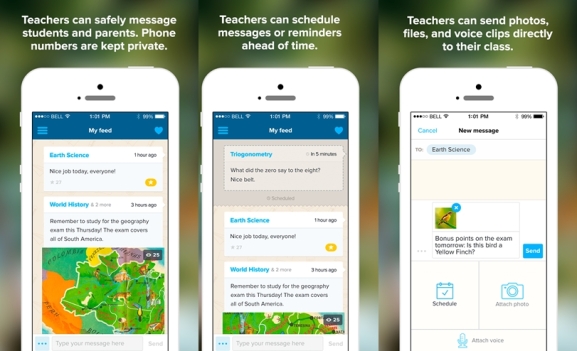ISTE Standard 3 recommends teachers utilize and adapt technology resources to promote effective learning and communication with students, peers, and parents. Educators should routinely evaluate how technology can help create learning opportunities during the school day and assist with interaction outside of regular school hours. This standard expects teachers to use technology tools to exchange ideas, create new content, and become a model digital citizen for students.
While learning about ISTE Standards 1 and 2 I researched how to use technology to work with students, so Standard 3 made me wonder what resources are available to communicate with parents. The specific question I asked was: What digital tools do students and parents find most useful that effectively impacts learning and improves communication while being easy to use on a regular basis? When I started thinking about this question I assumed that many teachers primarily communicate through email, but I do not think email is the best solution. Emails can be quite formal, easily ignored, time-consuming, and challenging to personalize for each student. Instead, I wanted to find a technology platform that allowed easy communication while supporting student learning.
My research indicated there are several communication sources available so parents and teachers can easily contact each other. I was a bit surprised to find out that text-messaging programs are quickly becoming the preferred method of contact between parents and teachers. Text message preference is likely because Smartphone ownership among adults has increased from 35% in 2011 to 64% in 2015 (Gilgore, 2015). More importantly, studies have also found that student academic performance is improved when parents and teachers communicate by frequent text-messaging (Gilgore, 2015). As a teacher, it is encouraging to learn that taking time to send parents messages likely benefits student achievement too. Even if text messages are a preferred source, experts recommend teachers use multiple resources to reach all parents (Gilgore, 2015). This is a very important recommendation because technology is constantly advancing and teachers have to remember that not all parents have access to the new technology. Remind is an example of a multi-approach resource so teachers can communicate with parents and students by email, text messages, and phone calls. Phone numbers are hidden which is a benefit to all users. One user of this program stated he prefers the mixture of communication options because then he feels like he is reaching more parents (Gilgore, 2015). Image 1 below shows a teacher’s view of Remind on a Smartphone along with a few features of the program. Remind appears to be an option that is age appropriate for all students and user-friendly for parents.

One of my classmates asked a similar question about ISTE Standard 3. He discussed a digital resource called ClassDojo, which his school has already integrated. This program offers a range of options including direct messaging, class announcements, and tracking students’ academic and behavioral progress. The site also indicates that read receipts are available, which I think is a major benefit because then teachers can easily monitor who has seen important information. I like that this platform provides teachers the opportunity to provide both student feedback and message options to parents since no one wants to be using too many digital tools. The visuals and feedback in ClassDojo appear geared toward elementary school students, so I am not sure it would be the best fit for secondary school students and teachers.
Deciding which digital tool to use is often the biggest challenge for educators, especially future teachers who are still in teaching programs. The options can be overwhelming and there are numerous factors to consider. Many preservice teachers have reported a high level of familiarity with technology and using digital tools on a daily basis, but studies indicate preservice teachers are not appropriately prepared to utilize technology resources in their classrooms (Kumar and Vigil, 2011). I think this is likely because the current generation of students in teaching programs did not experience a high degree of digital tool integration in their childhood education. Technology tools have primarily been used for social or personal purposes. While preservice teachers understand the value of technology, they do not have as much experience with using or observing educational digital tools. Kumar and Vigil (2011) recommend teaching programs include technology learning experiences as part of curriculum so preservice teachers can practice evaluating digital tools and creating content. This is a reasonable proposal and I think it will result in a generation of teachers who more seamlessly integrate technology resources with instruction, content, and communication.
The best communication option depends on if parents have the appropriate devices and technology skills to effectively utilize the digital tools. Another consideration is if the school district has already integrated a preferred communication source. Teachers should use the platform the district offers; otherwise it might cause parents to become frustrated if they have more than one child in the district and every teacher is using a different source. The goal is to make communication straightforward and easy for parents. Teachers also have to observe the user response of communication. If parents are not utilizing a certain source, then perhaps it is a better decision to not devote time and resources to that platform. Similar to all aspects of technology, teachers will learn overtime and through experiences which resources are most helpful and what parents prefer.
References:
Gilgore, S. (September 15, 2015). Probing the impact of parent-teacher digital communication. Education Week, 34(4). Retrieved from http://www.edweek.org/ew/articles/2015/09/16/probing-the-impact-of-parent-teacher-digital-communication.html?tkn=PZLFl%2B2EVpiQ9No5OZdvNeDXBP0JZV3HgXt3&print=1
Kumar, S. & Vigil, K. (2011). The net generation as preservice teachers: Transferring familiarity with new technologies to education environments. Journal of Digital Learning in Teacher Education, 27(3), 144-153. Retrieved from: https://canvas.instructure.com/courses/992608/files/39077536?module_item_id=8641953
Your statement about the challenges of choosing which resource to use has left me relieved that my endorsement area (health and fitness) helps to narrow the amount of practical resources down for me. As a general education educator, I can imagine the struggle in weighing pros and cons for dozens of resources. Good hunting!
LikeLike